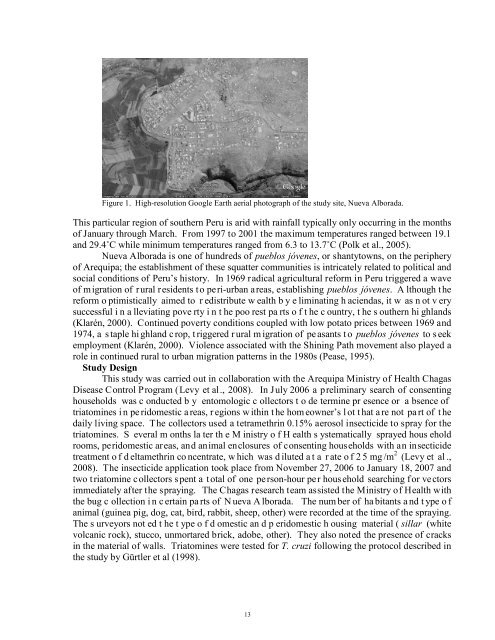Space Grant Consortium - University of Wisconsin - Green Bay
Space Grant Consortium - University of Wisconsin - Green Bay
Space Grant Consortium - University of Wisconsin - Green Bay
You also want an ePaper? Increase the reach of your titles
YUMPU automatically turns print PDFs into web optimized ePapers that Google loves.
Figure 1. High-resolution Google Earth aerial photograph <strong>of</strong> the study site, Nueva Alborada.<br />
This particular region <strong>of</strong> southern Peru is arid with rainfall typically only occurring in the months<br />
<strong>of</strong> January through March. From 1997 to 2001 the maximum temperatures ranged between 19.1<br />
and 29.4˚C while minimum temperatures ranged from 6.3 to 13.7˚C (Polk et al., 2005).<br />
Nueva Alborada is one <strong>of</strong> hundreds <strong>of</strong> pueblos jóvenes, or shantytowns, on the periphery<br />
<strong>of</strong> Arequipa; the establishment <strong>of</strong> these squatter communities is intricately related to political and<br />
social conditions <strong>of</strong> Peru’s history. In 1969 radical agricultural reform in Peru triggered a wave<br />
<strong>of</strong> migration <strong>of</strong> rural residents to peri-urban areas, establishing pueblos jóvenes. A lthough the<br />
reform o ptimistically aimed to r edistribute w ealth b y e liminating h aciendas, it w as n ot v ery<br />
successful i n a lleviating pove rty i n t he poo rest pa rts o f t he c ountry, t he s outhern hi ghlands<br />
(Klarén, 2000). Continued poverty conditions coupled with low potato prices between 1969 and<br />
1974, a s taple hi ghland c rop, t riggered r ural m igration <strong>of</strong> pe asants t o pueblos jóvenes to s eek<br />
employment (Klarén, 2000). Violence associated with the Shining Path movement also played a<br />
role in continued rural to urban migration patterns in the 1980s (Pease, 1995).<br />
Study Design<br />
This study was carried out in collaboration with the Arequipa Ministry <strong>of</strong> Health Chagas<br />
Disease Control Program (Levy et al., 2008). In July 2006 a preliminary search <strong>of</strong> consenting<br />
households was c onducted b y entomologic c ollectors t o de termine pr esence or a bsence <strong>of</strong><br />
triatomines i n pe ridomestic a reas, r egions w ithin t he hom eowner’s l ot t hat a re not pa rt <strong>of</strong> t he<br />
daily living space. The collectors used a tetramethrin 0.15% aerosol insecticide to spray for the<br />
triatomines. S everal m onths la ter th e M inistry o f H ealth s ystematically sprayed hous ehold<br />
rooms, peridomestic areas, and animal enclosures <strong>of</strong> consenting households with an insecticide<br />
treatment o f d eltamethrin co ncentrate, w hich was d iluted a t a r ate o f 2 5 mg /m 2 (Levy et al .,<br />
2008). The insecticide application took place from November 27, 2006 to January 18, 2007 and<br />
two triatomine collectors spent a total <strong>of</strong> one person-hour per household searching for vectors<br />
immediately after the spraying. The Chagas research team assisted the Ministry <strong>of</strong> Health with<br />
the bug c ollection i n c ertain pa rts <strong>of</strong> N ueva A lborada. The num ber <strong>of</strong> ha bitants a nd t ype o f<br />
animal (guinea pig, dog, cat, bird, rabbit, sheep, other) were recorded at the time <strong>of</strong> the spraying.<br />
The s urveyors not ed t he t ype o f d omestic an d p eridomestic h ousing material ( sillar (white<br />
volcanic rock), stucco, unmortared brick, adobe, other). They also noted the presence <strong>of</strong> cracks<br />
in the material <strong>of</strong> walls. Triatomines were tested for T. cruzi following the protocol described in<br />
the study by Gürtler et al (1998).<br />
13

















